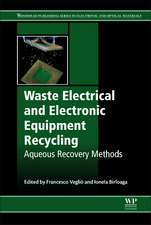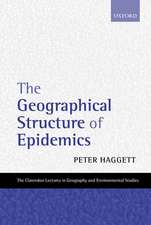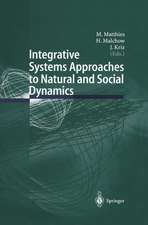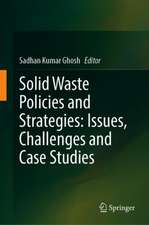Emerging and Eco-Friendly Approaches for Waste Management
Editat de Ram Naresh Bharagava, Pankaj Chowdharyen Limba Engleză Paperback – 11 feb 2019
This book provides a comprehensive overview of various toxic environmental pollutants from avariety natural and anthropogenic sources, their toxicological effects on the environment, humans, animals and plants as well as their biodegradation and bioremediation using emerging and eco-friendly approaches (e.g. Anammox technology, advanced oxidation processes, membrane bioreactors, membrane processes, GMOs), microbial degradation (e.g. bacteria, fungi, algae), phytoremediation, biotechnology and nanobiotechnology. Offering fundamental and advanced information on environmental problems, challenges and bioremediation approaches used for the remediation of contaminated sites, it is a valuable resource for students, scientists and researchers engaged in microbiology, biotechnology and environmental sciences.
| Toate formatele și edițiile | Preț | Express |
|---|---|---|
| Paperback (1) | 796.03 lei 38-44 zile | |
| Springer Nature Singapore – 11 feb 2019 | 796.03 lei 38-44 zile | |
| Hardback (1) | 812.34 lei 38-44 zile | |
| Springer Nature Singapore – 8 iun 2018 | 812.34 lei 38-44 zile |
Preț: 796.03 lei
Preț vechi: 1047.40 lei
-24% Nou
Puncte Express: 1194
Preț estimativ în valută:
152.32€ • 159.03$ • 126.06£
152.32€ • 159.03$ • 126.06£
Carte tipărită la comandă
Livrare economică 01-07 aprilie
Preluare comenzi: 021 569.72.76
Specificații
ISBN-13: 9789811342097
ISBN-10: 9811342091
Pagini: 435
Ilustrații: XVI, 435 p. 62 illus., 38 illus. in color.
Dimensiuni: 155 x 235 mm
Ediția:Softcover reprint of the original 1st ed. 2019
Editura: Springer Nature Singapore
Colecția Springer
Locul publicării:Singapore, Singapore
ISBN-10: 9811342091
Pagini: 435
Ilustrații: XVI, 435 p. 62 illus., 38 illus. in color.
Dimensiuni: 155 x 235 mm
Ediția:Softcover reprint of the original 1st ed. 2019
Editura: Springer Nature Singapore
Colecția Springer
Locul publicării:Singapore, Singapore
Cuprins
Chapter 1. Conventional methods for the removal of industrial pollutants, their merits and demerits.- Chapter 2. Toxicological Aspects of Emerging Contaminants.- Chapter 3. An Overview of the Potential of Bioremediation for Contaminated Soil from Municipal Solid Waste Site.- Chapter 4. Anammox Cultivation in a submerged membrane bioreactor.- Chapter 5. Toxicity, beneficial aspect and treatment of alcohol industry wastewater.- Chapter 6. Bioremediation approaches for degradation and detoxification of Polycyclic Aromatic Hydrocarbons.- Chapter 7. Endocrine Disrupting Pollutants in Industrial Wastewater and Their Degradation and Detoxification Approaches.- Chapter 8. Arsenic toxicity and its remediation strategies to fight the environmental threat.- Chapter 9. Microalgal treatment of alcohol distillery wastewater.- Chapter 10. Endophytes: Emerging tools for the bioremediation of pollutants.- Chapter 11. Textile wastewater Dyes: Toxicity profile and treatment approaches.- Chapter 12.Pesticides Contamination: Environmental Problems and its Remediation Strategies.- Chapter 13. Recent advances in physico-chemical and biological techniques for the management of pulp and paper mill waste.- Chapter 14. Role of rhizobacteria in phytoremediation of metal contaminated sites.- Chapter 15. Immobilized peroxidases as an efficient tool for the remediation of phenolic compounds from polluted water.- Chapter 16. "Nanoparticles: An emerging weapon for mitigation/removal of various environmental pollutants for environmental safety
".- Chapter 17. Biphasic treatment system for the removal of toxic and hazardous pollutants from industrial wastewaters.- Chapter 18. Phycotechnological approaches towards wastewater management.
Notă biografică
Dr. Ram Naresh Bharagava is presently working as Assistant Professor at the Department of Environmental Microbiology, Babasaheb Bhimrao Ambedkar University, Uttar Pradesh, India.
Dr. Pankaj Chowdhary is currently working as a research scholar at Department of Environmental Microbiology, Babasaheb Bhimrao Ambedkar University, Uttar Pradesh, India. His work focuses on distillery wastewater pollutants and their effect on the environment. He has published 6 book chapters, 5 academic papers and 2 magazine articles. He has also presented a conference paper.
Dr. Pankaj Chowdhary is currently working as a research scholar at Department of Environmental Microbiology, Babasaheb Bhimrao Ambedkar University, Uttar Pradesh, India. His work focuses on distillery wastewater pollutants and their effect on the environment. He has published 6 book chapters, 5 academic papers and 2 magazine articles. He has also presented a conference paper.
Textul de pe ultima copertă
Rapid industrialization is a serious concern in the context of a healthy environment. With the growth in the number of industries, the waste generated is also growing exponentially. The various chemical processes operating in the manufacturing industry generate a large number of by-products, which are largely harmful and toxic pollutants and are generally discharged into the natural water bodies. Once the pollutants enter the environment, they are taken up by different life forms, and because of bio-magnification, they affect the entire food chain and have severe adverse effects on all life forms, including on human health. Although, various physico-chemical and biological approaches are available for the removal of toxic pollutants, unfortunately these are often ineffective and traditional clean up practices are inefficient. Biological approaches utilizing microorganisms (bacterial/fungi/algae), green plants or their enzymes to degrade or detoxify environmental pollutants such as endocrine disruptors, toxic metals, pesticides, dyes, petroleum hydrocarbons and phenolic compounds, offer eco- friendly approaches. Such eco-friendly approaches are often more effective than traditional practices, and are safe for both industry workers as well as environment.
This book provides a comprehensive overview of various toxic environmental pollutants from avariety natural and anthropogenic sources, their toxicological effects on the environment, humans, animals and plants as well as their biodegradation and bioremediation using emerging and eco-friendly approaches (e.g. Anammox technology, advanced oxidation processes, membrane bioreactors, membrane processes, GMOs), microbial degradation (e.g. bacteria, fungi, algae), phytoremediation, biotechnology and nanobiotechnology. Offering fundamental and advanced information on environmental problems, challenges and bioremediation approaches used for the remediation of contaminated sites, it is a valuable resource for students, scientists and researchers engaged in microbiology, biotechnology and environmental sciences.
This book provides a comprehensive overview of various toxic environmental pollutants from avariety natural and anthropogenic sources, their toxicological effects on the environment, humans, animals and plants as well as their biodegradation and bioremediation using emerging and eco-friendly approaches (e.g. Anammox technology, advanced oxidation processes, membrane bioreactors, membrane processes, GMOs), microbial degradation (e.g. bacteria, fungi, algae), phytoremediation, biotechnology and nanobiotechnology. Offering fundamental and advanced information on environmental problems, challenges and bioremediation approaches used for the remediation of contaminated sites, it is a valuable resource for students, scientists and researchers engaged in microbiology, biotechnology and environmental sciences.
Caracteristici
Comprehensive knowledge on the various natural and anthropogenic sources of toxic environmental pollutants Elucidate biodegradation and bioremediation approaches for the management and clean-up of polluted environments for sustainable development. Provides detailed knowledge on the various physico-chemical and biological techniques of waste management with their merits, demerits and future prospects. Elaborates emerging and environmental friendly approaches and their sustainable by-products.



























